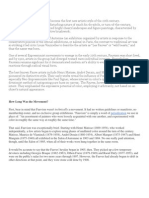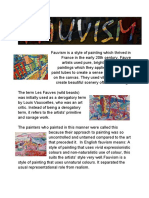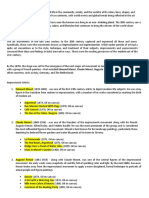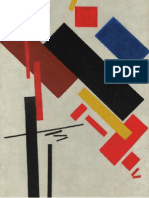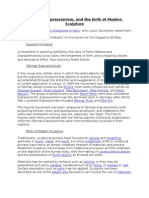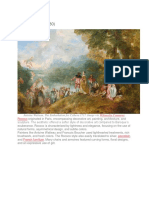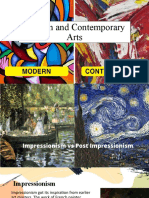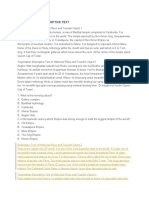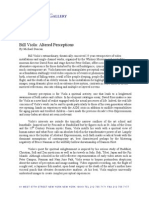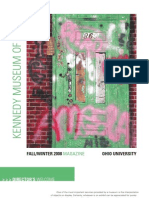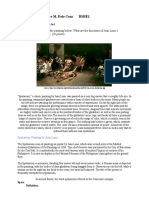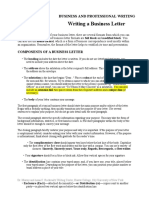Fauvism
Fauvism
Uploaded by
manil orpanCopyright:
Available Formats
Fauvism
Fauvism
Uploaded by
manil orpanCopyright
Available Formats
Share this document
Did you find this document useful?
Is this content inappropriate?
Copyright:
Available Formats
Fauvism
Fauvism
Uploaded by
manil orpanCopyright:
Available Formats
Fauvism
Fauvism, the name of which means “wild beasts.”style of painting that flourished
in France around the turn of the 20th century. Fauve artists used pure, brilliant colour
aggressively applied straight from the paint tubes to create a sense of an explosion on
the canvas.The Fauves painted directly from nature, as the Impressionists had before
them, but Fauvist works were invested with a strong expressive reaction to the
subjects portrayed. The leader of the group was Henri Matisse, who had arrived at the
Fauve style after experimenting with the various Post-Impressionist approaches
Matisse’s studies led him to reject traditional renderings of three-dimensional space
and to seek instead a new picture space defined by movement of colour. He exhibited
his famous Woman with the Hat (1905) at the 1905 exhibition. In this painting, brush
strokes of colour—blues, greens, and reds—form an energetic, expressive view of the
woman. The crude paint application, which left areas of raw canvas exposed, was
appalling to viewers at the time.
The other major Fauvists were André Derain, who had attended school with Matisse
in 1898–99, and Maurice de Vlaminck, who was Derain’s friend. They shared
Matisse’s interest in the expressive function of colour in painting, and they first
exhibited together in 1905. Derain’s Fauvist paintings translate every tone of a
landscape into pure colour, which he applied with short, forceful brushstrokes. The
agitated swirls of intense colour in Vlaminck’s works are indebted to the expressive
power of van Gogh.
Henri Matisse
Luxe, Calme, et Volupté (Luxury, Calm, and Desire), 1904
Radical Color and Wild Beasts:
Matisse, Derain, and the Friendship
that Defined Fauvism
In 1905, French painters André Derain and Henri
Matisse spent a summer in the South of France exploring a
new freedom and spontaneity in painting; characterized by
vibrant color, painterly, expressive brushstrokes, and an
irreverent approach to the idea of representation in art, they
defined what became the essential style of Fauvism, a brief
but influential avant-garde art movement.
André Derain
L'Estaque, 1905
André Derain
Charing Cross Bridge, London, 1906
Musée d'Orsay, Paris
Henri Matisse
(Woman with a Hat), 1905
The Dance by Henri Matisse
Joy of Life 1905 by Henri Matisse
Town on the Bank of a Lake, paintings by Maurice de Vlaminck
village
landscape paintings by Maurice de Vlaminck
You might also like
- Anthony M. Snodgrass - Arms and Armor of The Greeks-The Johns Hopkins University Press (1998) PDFDocument182 pagesAnthony M. Snodgrass - Arms and Armor of The Greeks-The Johns Hopkins University Press (1998) PDFasblade1100% (1)
- Top 10 Athens (DK Eyewitness Top 10 Travel Guide)Document162 pagesTop 10 Athens (DK Eyewitness Top 10 Travel Guide)ionut nicolae100% (4)
- A History of Architecture - Banister Fletcher (1953) - 20th Ed. Dan Cruickshank (1996)Document1,832 pagesA History of Architecture - Banister Fletcher (1953) - 20th Ed. Dan Cruickshank (1996)Ludwig Szoha100% (1)
- FAUVISMDocument24 pagesFAUVISM니콜Nicole100% (1)
- Fauvism OlaDocument48 pagesFauvism OlaMo hebaaaNo ratings yet
- Fauvism: How Long Was The Movement?Document10 pagesFauvism: How Long Was The Movement?Doremon G FlyNo ratings yet
- Fauvism: A Style of Painting That Flourished in France Around The Turn of The 20 CenturyDocument5 pagesFauvism: A Style of Painting That Flourished in France Around The Turn of The 20 CenturyDarryl ReyNo ratings yet
- Fauvism ArtDocument7 pagesFauvism ArtFakhrul IzzuddinNo ratings yet
- FAUVISMDocument6 pagesFAUVISMAubreyCapule0% (1)
- FauvismDocument2 pagesFauvismMariana RecagnoNo ratings yet
- FAUVISMDocument2 pagesFAUVISMJerona AyongNo ratings yet
- Blooms Bury Group & FauvismDocument30 pagesBlooms Bury Group & FauvismShachi PandeyNo ratings yet
- FauvismDocument24 pagesFauvismmariamalilone5No ratings yet
- FauvismDocument20 pagesFauvismjordaliza buyagao100% (2)
- FauvismDocument5 pagesFauvismGautam JainNo ratings yet
- FauvismDocument4 pagesFauvismAlejandro Renzo LimNo ratings yet
- FAUVISMODocument4 pagesFAUVISMOGricelda GonzalezNo ratings yet
- What Is Modern ArtDocument85 pagesWhat Is Modern Artnidhisanjeet100% (1)
- FauvismDocument33 pagesFauvismCaila Dominique AlmeidaNo ratings yet
- FAUVISMDocument3 pagesFAUVISMcutiedaisy225No ratings yet
- 'FauvismDocument24 pages'Fauvismnishantmm0% (1)
- Reporting FauvismDocument12 pagesReporting FauvismSHERRY MARQUEZNo ratings yet
- FauvismDocument5 pagesFauvismsubirNo ratings yet
- FauvismDocument4 pagesFauvismAleksandra ButorovicNo ratings yet
- Agas GED108 EX2 FauvismDocument6 pagesAgas GED108 EX2 FauvismbeatriceagasNo ratings yet
- Technique and Style in PaintingDocument6 pagesTechnique and Style in PaintingLeanne Heart SanchezNo ratings yet
- Edutopia STW Bates Artsintegration LAlessonplanportrait PresentaDocument29 pagesEdutopia STW Bates Artsintegration LAlessonplanportrait Presentaon my way patipatiNo ratings yet
- Symbolism and FauvismDocument9 pagesSymbolism and FauvismNelchie DalenNo ratings yet
- HH Arnason - Fauvism (Ch. 07)Document16 pagesHH Arnason - Fauvism (Ch. 07)KraftfeldNo ratings yet
- Derain The Dance' 1906 and PrimitivismDocument8 pagesDerain The Dance' 1906 and PrimitivismgftuNo ratings yet
- Mapeh ReviewerDocument20 pagesMapeh ReviewerKaryll Althea RamosNo ratings yet
- Fauvism English ReaderDocument10 pagesFauvism English ReaderWrishi BiswasNo ratings yet
- FauvismDocument21 pagesFauvismapi-327259913No ratings yet
- Fauvism Is A Style of Painting Which Thrived in France Around The Early 20th CenturyDocument2 pagesFauvism Is A Style of Painting Which Thrived in France Around The Early 20th CenturyloooliNo ratings yet
- Arts Reviewer 8915Document7 pagesArts Reviewer 8915queridaria47No ratings yet
- Arts Reviewer 09-17-24Document7 pagesArts Reviewer 09-17-24shiyoinnnnNo ratings yet
- Origins: Fauvism Is The Style of Les Fauves (Document2 pagesOrigins: Fauvism Is The Style of Les Fauves (Mariana RecagnoNo ratings yet
- FauvismDocument34 pagesFauvismsarah ahmedNo ratings yet
- Secondary Arts 10 Q1 Module3Document16 pagesSecondary Arts 10 Q1 Module3Mer Lyn100% (1)
- Technique and Style in Painting: Humanities 100Document51 pagesTechnique and Style in Painting: Humanities 100Mika Sophia Gonzaga100% (1)
- Grade 10 Arts PPT Quarter 1 Complete W Assessment 1Document58 pagesGrade 10 Arts PPT Quarter 1 Complete W Assessment 1Regner Borneo100% (1)
- Moma Catalogue 375 300063063Document14 pagesMoma Catalogue 375 300063063Eric Ciaramella Is A Piece Of TrashNo ratings yet
- Reading Materials Arts 1Document10 pagesReading Materials Arts 1Nerissa Lejano RosasNo ratings yet
- Modern Art Learning Activity Sheet - 2 PDFDocument10 pagesModern Art Learning Activity Sheet - 2 PDFAlyza ApigoNo ratings yet
- Mapeh ReviewerDocument4 pagesMapeh ReviewerbsahdnasNo ratings yet
- Arts (1st QT)Document3 pagesArts (1st QT)Adriela AlonNo ratings yet
- Paths To Abstraction 1867-1917Document8 pagesPaths To Abstraction 1867-1917Merih Kunur75% (4)
- Mapeh ReviewerDocument5 pagesMapeh ReviewerKaryll Althea RamosNo ratings yet
- Modern Arts: Presented by GROUP 2Document52 pagesModern Arts: Presented by GROUP 2Kathlene Joy Ballesteros IINo ratings yet
- Post Impressionism (1885-1910)Document9 pagesPost Impressionism (1885-1910)Jiesa Jay Funa100% (1)
- Art MovementDocument11 pagesArt MovementSuzy LeeNo ratings yet
- Methods-of-PresDocument43 pagesMethods-of-PresAdelade MaryosaNo ratings yet
- First Quarter Modern Art Grade 10Document3 pagesFirst Quarter Modern Art Grade 10Adrian NovillaNo ratings yet
- Gr. 10 Arts Handouts Q1Document3 pagesGr. 10 Arts Handouts Q1JAMES LOUI ENATONo ratings yet
- Fauvism Expressionism and SculptureDocument4 pagesFauvism Expressionism and SculptureA M ZNo ratings yet
- Modern ArtDocument94 pagesModern ArtRome Billote100% (2)
- Western Art After RococoDocument14 pagesWestern Art After RococoJosephine MakNo ratings yet
- Modern and Contemporary ArtsDocument18 pagesModern and Contemporary Artsliop100% (1)
- Impressionism Vs Expressionism: by Daisy MariposaDocument4 pagesImpressionism Vs Expressionism: by Daisy MariposaMaria Fe VibarNo ratings yet
- Modern ArtsDocument42 pagesModern ArtsSuperKing CowBabyNo ratings yet
- Fauvism Is The Style of Les Fauves (Document1 pageFauvism Is The Style of Les Fauves (Mariana RecagnoNo ratings yet
- From Impressionism to Post-Impressionism - Art History Book for Children | Children's Arts, Music & Photography BooksFrom EverandFrom Impressionism to Post-Impressionism - Art History Book for Children | Children's Arts, Music & Photography BooksNo ratings yet
- New Update Class Rutine Fall2024-1Document2 pagesNew Update Class Rutine Fall2024-1manil orpanNo ratings yet
- Painting_at_Murshidabad_1750_1820_in_MuDocument29 pagesPainting_at_Murshidabad_1750_1820_in_Mumanil orpanNo ratings yet
- Premier University Class Rutine Fall 2024 Fdt PucDocument2 pagesPremier University Class Rutine Fall 2024 Fdt Pucmanil orpanNo ratings yet
- Byzantine DressDocument8 pagesByzantine Dressmanil orpanNo ratings yet
- Pre Test ARTS10 Q1Document3 pagesPre Test ARTS10 Q1Bernivie TenajaNo ratings yet
- Sabatino Moscati - The World of The Phoenicians-Cardinal (1973)Document347 pagesSabatino Moscati - The World of The Phoenicians-Cardinal (1973)Daniel BarboNo ratings yet
- Historical Data From The Manuscripts of The Khiva Ornamental Artist Abdulla BaltaevDocument9 pagesHistorical Data From The Manuscripts of The Khiva Ornamental Artist Abdulla Baltaevindex PubNo ratings yet
- Soal Tentang Descriptive TextDocument6 pagesSoal Tentang Descriptive TextAndri RetnoNo ratings yet
- Teaching Arts in Elementary Grades: LESSON 3: PRINCIPLES OF ARTDocument16 pagesTeaching Arts in Elementary Grades: LESSON 3: PRINCIPLES OF ARTJorielyn ApostolNo ratings yet
- Actividad 1 Modulo 7Document3 pagesActividad 1 Modulo 7Gaby JimenezNo ratings yet
- HhjikkDocument744 pagesHhjikkJoselitoDegomaNo ratings yet
- Bill Viola - Altered Perceptions by Michael DuncanDocument5 pagesBill Viola - Altered Perceptions by Michael DuncanHugo PierotNo ratings yet
- Chhatrapati Shivaji Maharaj Vastu SangrahalayaDocument6 pagesChhatrapati Shivaji Maharaj Vastu Sangrahalaya2GI18AT068No ratings yet
- London Philatelist: The Philatelic Society, LondonDocument20 pagesLondon Philatelist: The Philatelic Society, LondonVIORELNo ratings yet
- Fall / Winter 2008Document13 pagesFall / Winter 2008Tony ManniraNo ratings yet
- Famous Cities in Anglo-Saxon Cultural SpaceDocument21 pagesFamous Cities in Anglo-Saxon Cultural Spacerodica enacheNo ratings yet
- Activity #03 - Functions of ArtDocument3 pagesActivity #03 - Functions of ArtKassandra Dela CruzNo ratings yet
- B - A - History Heritage Management 1Document14 pagesB - A - History Heritage Management 1nivedidha arulselvamNo ratings yet
- Active Collections and MeaningDocument6 pagesActive Collections and Meaningapi-621525562No ratings yet
- National Artist in Visual Artist (Glenn Trono)Document72 pagesNational Artist in Visual Artist (Glenn Trono)Glenn TronoNo ratings yet
- Samples of Business LettersDocument6 pagesSamples of Business LettersRameshchandra SinghNo ratings yet
- Anh 6 de Cuong HKI 23 24Document6 pagesAnh 6 de Cuong HKI 23 24Thanh Tran MinhNo ratings yet
- What Did Rizal ReadDocument16 pagesWhat Did Rizal ReadLawrenceNo ratings yet
- London Philatelist:: The Fourthcoming London Philatelic ExhibitionDocument24 pagesLondon Philatelist:: The Fourthcoming London Philatelic ExhibitionVIORELNo ratings yet
- Museums, Collections and Society: Yearbook 2020Document7 pagesMuseums, Collections and Society: Yearbook 2020Marcela CabralitNo ratings yet
- James McNeill WhistlerDocument9 pagesJames McNeill WhistlerDavid BriceñoNo ratings yet
- Blackbook 1Document39 pagesBlackbook 1yash baheti100% (1)
- Art of The People Pierre Alechinsky andDocument10 pagesArt of The People Pierre Alechinsky andpoubellepourpubfortNo ratings yet
- Conversation Corner Art Who Painted These Fun Activities Games 2713Document2 pagesConversation Corner Art Who Painted These Fun Activities Games 2713Wilson Sanchez AvizNo ratings yet
- 3-Women Contribution To The War Effort - WHTDocument4 pages3-Women Contribution To The War Effort - WHTKristell DaisyNo ratings yet
- Amyt ResumeDocument1 pageAmyt Resumeapi-729743958No ratings yet





